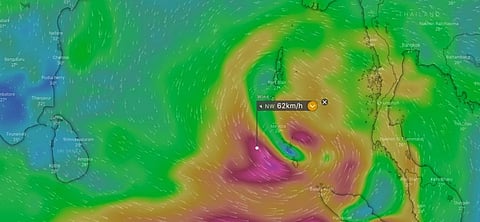

India, which has been reeling under heatwave conditions since March, may be finally in for some relief as the India Meteorological Department (IMD) on May 2, 2022, predicted the formation of a cyclonic circulation over the South Andaman Sea by May 4.
The cyclonic circulation would lead to the formation of a low pressure area on May 6. The IMD also predicted the intensification of the system in the subsequent 24 hours.
Data from the Global Forecasting System (GFS), as represented on the Windy.com weather visualisation platform, showed further intensification of the system from May 7 onwards and movement towards the Odisha and Andhra coasts.
Data from the European Centre for Medium-Range Weather Forecasting (ECMWF), as represented on Windy.com, agreed with the GFS data on the formation of the low pressure area and its intensification. But it predicted that the low pressure area would move towards the Odisha and West Bengal coasts.
The unpredictability of cyclonic intensification and movement in recent years should be taken as caution when taking action to mitigate the impact of the cyclone.
For instance, back in February and March, there were a couple of low pressure areas in the Bay of Bengal that threatened to form the season’s first cyclone. But they remained at the intensity of a deep depression, a notch lower than a cyclone.
The first of these systems formed as a low pressure area on February 28 and went onto become a deep depression on March 4.
The second low pressure area formed on March 15 and intensified into a deep depression by March 21. The formation of two systems of the intensity of a depression or more in the month of March had happened for the first time in 122 years.
It is too early to predict the accurate levels of intensification and possible track of the cyclone. The IMD and the Joint Typhoon Warning System of the United States Navy will be keeping a close watch on the cyclone’s characteristics after it intensifies into a depression.
“Rapid warming in the north Indian Ocean, associated with global warming, tends to enhance the heat flux from the ocean to the atmosphere and favour the rapid intensification of cyclones,” wrote Roxy Mathew Koll in a review research paper on tropical cyclones in the north Indian Ocean region.
The review was published in the journal Earth-Science Review in February 2022. In 2020, Cyclone Amphan had intensified from about 100 km per hour to about 250 km per hour in less than 24 hours.
“Monitoring and forecasting rapid intensification is a challenge, particularly due to gaps in in-situ ocean observations. The quick intensification means that it does not provide sufficient time for evacuation and disaster management on the ground,” according to the paper.
If the cyclone does form, it may also become a cause for concern for the onset of the south west monsoon season over the Bay of Bengal and subsequently over the Indian mainland.
Such a disruption of the monsoon system has been observed in the last few years. In 2021, the back-to-back formation of extremely severe cyclone Tauktae in the Arabian Sea and very severe cyclone Yaas in the Bay of Bengal had disrupted the formation and movement of the monsoon system.
The south west monsoon is mainly driven by the temperature difference between the Indian mainland and the north Indian Ocean, which includes the Bay of Bengal and the Arabian Sea.
Cyclone Tauktae had brought lots of rainfall to the western coastal areas and it had also moved a considerable distance over north west India after making landfall along the Gujarat coast, which brought rainfall and cooled down temperatures in that region.
The high summer temperatures in this region are crucial in pulling the monsoon winds towards India for a timely and healthy onset of monsoon rains.
On the other hand, Cyclone Yaas formed just before the onset of the south west monsoon and pulled the monsoon winds, causing early and intense rainfall in many Indian states.
In some states like Bihar, it had led to floods in the month of June, even though Bihar normally receives most of its monsoon rainfall in July and August.
“One hopes that the monsoon trough will begin to move in from the northwestern tropical Pacific into the South China Sea and the Andaman Sea to start setting up the southwesterly winds across the equator by May 15,” Raghu Murtugudde, a climate scientist at the University of Maryland, said.
He had said the coming of the monsoon would dispel heat waves affecting India in the current spring and summer seasons.
Murtugudde had earlier predicted that late season cyclones in the Indian Ocean region may affect the formation of the monsoon system. What impact the current cyclone has on the heat waves and setting up of the south west monsoon season remains to be seen.